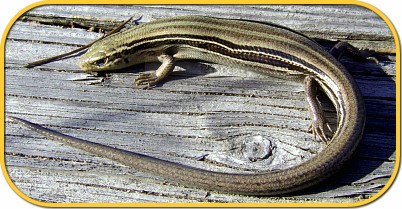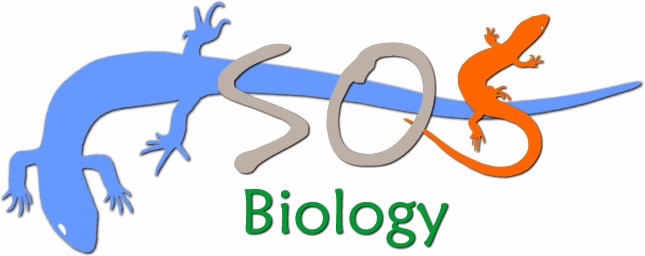| Biology
of Skinks
Skink Basics
 The
northern prairie skink (Plestiodon septentrionalis) is
a reptile. It belongs to a group, or family, of lizards known
as the Scincidae (pronounced “skink-i-day”). Skinks
are the most diverse group of lizards, with 1200 species worldwide.
The northern prairie skink is one of 27 species of skinks in
North America. As a group skinks have a typical lizard body
form, but have short, indistinct necks, short legs and long
tapering tails. Males of most species display orange or red
markings during the breeding season. In many North American
skinks juveniles have a bright blue tail.
The
northern prairie skink (Plestiodon septentrionalis) is
a reptile. It belongs to a group, or family, of lizards known
as the Scincidae (pronounced “skink-i-day”). Skinks
are the most diverse group of lizards, with 1200 species worldwide.
The northern prairie skink is one of 27 species of skinks in
North America. As a group skinks have a typical lizard body
form, but have short, indistinct necks, short legs and long
tapering tails. Males of most species display orange or red
markings during the breeding season. In many North American
skinks juveniles have a bright blue tail.
Description
 The
prairie skink is a small, slender lizard, olive-brown or grayish
in colour with alternating light and dark stripes running the
length of its body. The belly is light grey. Adult The
prairie skink is a small, slender lizard, olive-brown or grayish
in colour with alternating light and dark stripes running the
length of its body. The belly is light grey. Adult  skinks
can grow to a length of about 20 cm (about 8 inches), head to
tail, but half of that length is usually its tail. Females tend
to be a bit larger than males. Juvenile skinks have bright blue
tails. The blue colour fades as they reach adult size. During
the breeding season adult males develop orange colouration on
their heads and throats.
skinks
can grow to a length of about 20 cm (about 8 inches), head to
tail, but half of that length is usually its tail. Females tend
to be a bit larger than males. Juvenile skinks have bright blue
tails. The blue colour fades as they reach adult size. During
the breeding season adult males develop orange colouration on
their heads and throats. |
|
Names Explained
The scientific name for the northern prairie skink is Plestiodon septentrionalis (recently changed from Eumeces
septentrionalis). Plestiodon is thought to derive from the Greek: "pleistos", meaning "most, the most or the greatest", "odontos" is from the Greek, meaning "teeth" (thanks to John White for helping out with the etymology). The species name "septentrionalis"
is latin for "of the north". So they are the "most-toothed skinks of the north". The etymology of scientific
names, their underlying meaning, often seems more art than science,
except perhaps to the person that coined the name in the first
place.
The word "skink" comes from Latin "scincus"
or Greek "skinkos", which was the common name for
a of kind of lizard common in Asia and North Africa. The common
name for this lizard, "northern prairie skink", is
pretty obvious: a skink that lives in northern grassland regions.
There is, in fact, a southern prairie skink, too. The two are
considered to be subspecies, or different varieties, of the
prairie skink. Plestiodon septentrionalis septentrionalis
is the northern subspecies (our Manitoba Skink) while Plestiodon
septentrionalis obtusirostris (= blunt nose) is the southern
prairie skink. The ranges of these two critters are given in
the Biogeography section.
Habitat
 Habitat for skinks in Manitoba seems to be limited to areas
of mixed-grass prairie in sandy soils. (For some background
see Manitoba's
Mixed-grass Prairie in NatureNorth.com). In the open grasslands
the sun can reach and warm the ground. Skinks need this extra
warmth as part of their habitat. Many of the native grasses
have a tufted growth form (bunch grasses) that provide dense
cover for skinks and habitat for the skinks main prey, crickets
and spiders. Areas with very sandy soils are necessary for the
skinks to construct nests and burrows, especially for their
winter hibernation. In human populated areas artificial cover
objects, like boards or plywood, are sought-after cover for
skinks. Under such cover objects temperatures are favourable,
not too hot or too cool, and they often harbour the insects
skinks feed on.
Habitat for skinks in Manitoba seems to be limited to areas
of mixed-grass prairie in sandy soils. (For some background
see Manitoba's
Mixed-grass Prairie in NatureNorth.com). In the open grasslands
the sun can reach and warm the ground. Skinks need this extra
warmth as part of their habitat. Many of the native grasses
have a tufted growth form (bunch grasses) that provide dense
cover for skinks and habitat for the skinks main prey, crickets
and spiders. Areas with very sandy soils are necessary for the
skinks to construct nests and burrows, especially for their
winter hibernation. In human populated areas artificial cover
objects, like boards or plywood, are sought-after cover for
skinks. Under such cover objects temperatures are favourable,
not too hot or too cool, and they often harbour the insects
skinks feed on.
Physiology
Skinks, like most reptiles, are "cold-blooded",
or more properly "ectothermic". They don't produce
their own body heat like "warm-blooded", or endothermic,
animals: birds and mammals. Being an ectotherm means you don't
have to use up most of the energy you get in your food just
to make heat, so skinks can live on far less food than a comparably
sized bird or mammal. But it doesn't mean you have to give up
being active when temperatures are cool. Like most reptiles,
skinks can maintain a fairly warm body temperature (22 - 35
C) during day time by basking or seeking out warmer microhabitats.
They can maintain a constant temperature during sunny weather
by selecting spots to either warm or cool themselves. In cool,
cloudy weather skinks will be less active. At night they will
retreat to burrows or bury themselves under the sand and let
their body temperatures cool to that of the ground. |
|
Overwintering
For about 7 months of each year, from late September
to late April, skinks must avoid being active on the ground surface;
it's just too cold for them. They are not freeze tolerant like some
of Manitoba's frogs (see Frozen
Alive in NatureNorth.com). If a skink freezes, it dies. Skinks
must find burrows, or dig their own, where they can spend winter below
the frost line, which may be 1 m deep in southern Manitoba. This is
one reason they are limited to areas with sandy soils where it is
easy for them to dig to depths that will not freeze. As ectotherms
they let their body temperatures drop to the surroundings in their
burrows and require little food to survive their 7 months of cold
storage. The energy they store as body fat is enough for them to survive
their hibernation.
Life History
There is an excellent account of skink reproduction
in the NatureNorth article: The
Northern Prairie Skink, by Errol Bredin. Here is a quick synopsis.
 In Manitoba skinks emerge from hibernation in late April and early
May. Mating occurs in May or June. In late June or early July females
lay 4 to 18 eggs in shallow nests they dig, usually under some form
of cover. The female stays with her eggs until they hatch, in about
30 days, usually in early August. Then the hatchlings are abandoned
to make their own way in the world.
In Manitoba skinks emerge from hibernation in late April and early
May. Mating occurs in May or June. In late June or early July females
lay 4 to 18 eggs in shallow nests they dig, usually under some form
of cover. The female stays with her eggs until they hatch, in about
30 days, usually in early August. Then the hatchlings are abandoned
to make their own way in the world.
At 2 years of age skinks are full grown and can breed.
The life span for skinks is not well documented, but Errol Bredin
recaptured an adult after 5 years, suggesting that some can live for
up to 7 years.
Behaviour
Prairie skinks are secretive creatures spending most
of their time hidden under some form of cover. They tend to stay near
the ground and don't climb up shrubs or onto rocks. At night they
retreat into burrows to avoid the coolest temperatures and nocturnal
predators. Skinks are active from mid-morning to mid-afternoon when
temperatures are warmer. Spring and early summer, their mating period,
is when they are most active and most likely to be seen by people.
Their home ranges, the total area they live in, are quite small, often
less than 1000 square metres (1/10 ha or 1/4 acre). Skinks aren't
territorial so the home ranges of numerous skinks can overlap. They
tend to seek out areas with a south or west facing slope, sites that
will get more sun and stay warmer longer.
|
|
Populations
Skinks can occur in surprising numbers in areas of good
habitat. One researcher in the US estimated that skink densities ranged
from 50 to 200 individuals per hectare; that's up to 1 skink for every
50 square metres. Population densities for skinks in Manitoba haven't
been estimated yet.
Food Habits
Skinks are active predators, hunting and eating a variety
of insects and small invertebrates. Crickets and spiders seem to be
their favourite prey, but they will eat grasshoppers and a variety of
other insects. Cannibalism by adults on juveniles has been reported.
Skinks as Food
Skinks are food for a variety of larger predators. Snakes,
in particular the western hognose snake, will eat skinks. Kestrels,
crows and other predatory birds likely take their share, and mammals
like raccoons and skunks likely eat them, too. Large frogs or toads
would certainly be able to eat juvenile skinks.
 A
skink's main defense against being eaten is to stay under cover as much
as possible, but they have another trick they rely on. One characteristic
shared by most skink species is the ability to shed and regrow their
tails. If a predator attacks a skink and grabs it by the tail, the tail
will break off and continue to thrash around distracting the predator
long enough for the skink to make its escape. The surviving skink then
grows a new tail.
A
skink's main defense against being eaten is to stay under cover as much
as possible, but they have another trick they rely on. One characteristic
shared by most skink species is the ability to shed and regrow their
tails. If a predator attacks a skink and grabs it by the tail, the tail
will break off and continue to thrash around distracting the predator
long enough for the skink to make its escape. The surviving skink then
grows a new tail.
Additional Information
For more detailed information on the biology and conservation
status of the northern prairie skink in Manitoba download the COSEWIC
Status Report on the Northern Prairie Skink (1.3 MB PDF).
|

 The
prairie skink is a small, slender lizard, olive-brown or grayish
in colour with alternating light and dark stripes running the
length of its body. The belly is light grey. Adult
The
prairie skink is a small, slender lizard, olive-brown or grayish
in colour with alternating light and dark stripes running the
length of its body. The belly is light grey. Adult